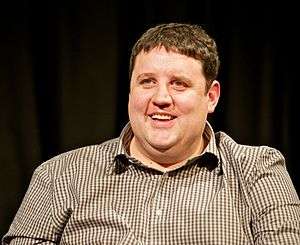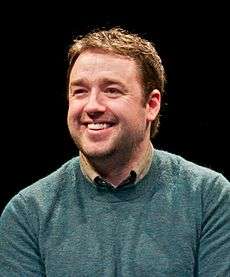University of Salford
 | |
| Motto | Altiora Petamus (Latin) |
|---|---|
Motto in English | "Let us seek higher things" |
| Type | Public |
| Established |
1850 - Pendleton Mechanics Institute 1896 – Royal Technical Institute, Salford 1967 – gained university status by Royal charter |
| Endowment | £49 m (2015)[1] |
| Chancellor | Jackie Kay MBE |
| Vice-Chancellor | Helen Marshall |
Administrative staff | 2,781 |
| Students | 19,995 (2016/17)[2] |
| Undergraduates | 15,475 (2016/17)[2] |
| Postgraduates | 4,520 (2016/17)[2] |
| Location | Salford, Greater Manchester, UK |
| Campus | Urban, Parkland |
| Colours | Black and red |
| Affiliations |
University Alliance Association of Commonwealth Universities North West Universities Association Northern Consortium |
| Website |
www |
 | |
The University of Salford, Manchester is a public research university in Salford, Greater Manchester, England, 1 mile (1.6 kilometres) west of Manchester city centre. The Royal Technical Institute, Salford, which opened in 1896, became a College of Advanced Technology in 1956 and gained university status, following the Robbins Report into higher education, in 1967.
It has 19,995 students and is in 160 acres (65 hectares) of parkland on the banks of the River Irwell.
History
Origins of the Royal Technical Institute
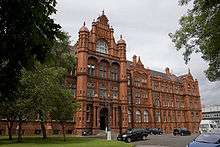
The university's origins can be traced to 1896 with the opening of the Royal Technical Institute, Salford, a merger of Salford Working Men's College founded in 1858 and Pendleton Mechanics' Institute founded in 1850.[3] The Royal Technical Institute, Salford received royal letters after the then-Duke and Duchess of York (later King George V and Queen Mary) officiated at its opening ceremony, an event commemorated in the university's Redbrick Peel Building and which allowed 'Royal' to be appended to the name of the institute.
At the start of the 20th century, mechanical engineering, chemical works, textiles and construction dominated the industrial scene in Salford. This heavily influenced the choice of subjects offered in the nine departments initially opened. These were Engineering, Electrical Engineering & Applied Physics, Mathematics, Chemistry, Building, Dyeing, Spinning & Weaving, Domestic, and Art. Some 1,240 students registered for the first session in these departments. There were originally 19 members of staff.
In 1921 the Institute was renamed the Royal Technical College, Salford. In 1958 the institution split into two organisations: the remaining Royal Technical College and a breakaway institution, Peel Park Technical College. This changed its name first in 1961 to Salford Technical College, before becoming the Salford College of Technology in 1970, and finally University College Salford in 1992.
Royal College of Advanced Technology
The Royal Technical College became a CAT in 1956, and became known as the Royal College of Advanced Technology. In 1963 the government completed an inquiry into the state of higher education in the United Kingdom and produced the Robbins Report, which paved the way for the Royal College of Advanced Technology (and other Colleges of Advanced Technology) to assume university status by Royal Charter.
University status
The Royal College of Advanced Technology became the University of Salford on 10 February 1967 when Queen Elizabeth II handed over the institution's Royal Charter. The first Vice-Chancellor was Clifford Whitworth, after whom the university's main library is named. The first chancellor was Prince Philip, Duke of Edinburgh, who remained the university's chancellor until 1991. Prince Philip took a keen interest in the university whilst in office which has continued since and he visited the university's award-winning acoustics laboratories in 2008.[4] In 1996 the breakaway University College Salford merged with the University of Salford, to form a single institution.
In 2012 the University of Salford announced a partnership with the UK's biggest arms company, (BAE Systems), and four other universities in northwestern England (Liverpool, Manchester, UCLAN and Lancaster) in order to work on the Gamma Programme, which aims to develop "autonomous systems". On 5 September 2015 Salford was represented for the third time on University Challenge.
Campus and facilities
.jpg)
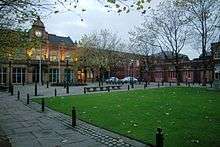
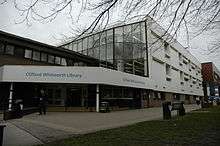
The main Peel Park campus is less than 1.5 miles (2.4 kilometres) from Manchester city centre on the banks of the River Irwell, adjacent to Peel Park, possibly the first public park in the world, which opened on 22 August 1846.[5] A former president of the Students' Union described Salford in 2007 as "a relaxed campus close to Manchester, but cheaper and greener."[6] Salford Crescent railway station is adjacent to the campus, and high frequency bus services operate to Manchester, Salford and Bolton and Liverpool. There are other university facilities within a mile of the main campus, namely the Frederick Road and Adelphi campuses. Most of the university administration buildings are along Salford Crescent, opposite the Peel Campus. The Salford Museum and Art Gallery, said to be the first unconditionally free public library in England,[7][8] is located on the Peel Park Campus.
MediaCityUK
In October 2010 the university opened a learning, teaching and research space at MediaCityUK.[9] Over 1,500 students will have opportunities to work near media professionals using the latest industry specified equipment, studios and laboratories.[10] They will study in 39 undergraduate and postgraduate programmes.[11]
Major investment projects

The university embarked on a £150 million programme of investment in 2004, to deliver new buildings and carry out major refurbishment projects. These included:
- £22m Mary Seacole Building, opened in 2006, the purpose-built five storey facility for the College of Health and Social Care.
- £10m Lady Hale Building for the Salford Law School which opened in February 2008. The whole building acts as its own night storage heating and cooling system thanks to a "Termodeck" system.
- £10m Innovation Forum Building
- Joule Physics Laboratory[12] provides a suite of new, purpose-built physics teaching laboratories and is named after James Prescott Joule, whose former home is situated opposite the Peel Building.
- Opened in October 2011 - A new building for the university's College of Arts, Media & Social Sciences designed by 3XN Architects[13] on the MediaCityUK site in Salford Quays - which will be home to five BBC departments.
In summer 2013 construction work started on the £55 million New Adelphi building, due to open in September 2016, housing music, performance, art, design and architecture students. Facilities will include a 350 capacity theatre, 140sqm studio theatre, 2 large TV acting studios, 36 dedicated rehearsal rooms, 6 industry standard recording studios, 12 amplified performance spaces (music ensemble rooms), 2 dance studios, 3 floors of dedicated wood, metal, textiles, print and plastics workshops, 7 photographic studios, 14 instrumental tuition rooms, a double height 100sqm band-room/live room and a suite of flexible performance and studio spaces.
The Library Development Project was conducted in two stages in 2016 and 2017, encompassing an extension and refurbishment of the Clifford Whitworth Library along the theme of 'the library in the park'.
In May 2016 an extension to the existing Newton Building, which houses the School of Computing, Science and Engineering, was awarded planning permission. The £16 million project, known as the Engineering Showcase, will feature exhibition space to display engineering solutions, research/demonstration spaces, open-plan collaborative learning spaces, informal and formal presentation spaces, a café and ‘maker-space’.
Facilities
Peel Hall has seating for nearly 400 people, hosts many musical performances and is the main venue for the midday recitals. The hall is housed in the Peel Building, a red brick and terracotta Victorian building on the Peel Park Campus.
The university's Robert Powell Theatre, named after the Salford-born actor, mostly stages live performances of modern works and participatory work for younger audiences.
At the heart of the Peel Park Campus, the Chapman Gallery hosts a wide range of modern and contemporary art exhibitions which showcase the work of up and coming artists, university staff, students and the community of Salford.
The Tom Husband Leisure Centre is on the Peel Park Campus and adjacent to the Students' Union. It contains a gym, 25m swimming pool, sauna and spa, squash courts, climbing wall, and a multi-use sports hall.
The Adelphi Studio Theatre is a small theatre venue based in the School of Music, Media and Performance's Adelphi Building.
Organisation and administration
Chancellors
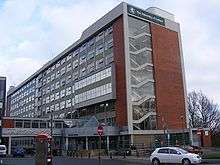
- Prince Philip, Duke of Edinburgh (1967–1991)
- Sarah, Duchess of York (1991–1995)
- Sir Walter Bodmer (1995-2005)
- Sir Martin Harris (2005–2009)[14]
- Irene Zubaida Khan (2009–2014)[15]
- Jackie Kay (2014–present)
Vice-Chancellors
- Clifford Whitworth (1967–74)
- John Harold Horlock (1974–81)
- Sir John Michael Ashworth (1981–90)
- Thomas Mutrie Husband (1990–97)
- Michael Harloe (1997–2009)
- Martin Hall (2009–2014)
- Helen Marshall (2015-)
Research and development centres
The United National Institute for Prosthetics and Orthotics Development[16] is located in the University's Prosthetics and Orthotics division of its School of Health, Sport and Rehabilitation Sciences. It is the only prosthetics and orthotics higher education provider in England.
The KidsCan Children's Cancer Research Centre is in the University's John Armstrong Welsh Laboratories at the Centre for Biochemistry, Drug Design and Cancer Research.[17] It was established in 2002 to develop treatments with fewer side effects for children and young adults.[18]
Academic profile
The university is organised into seven schools:[19]
- School of Arts and Media
- Salford Business School
- School of Health Sciences
- School of Health and Society
- NB — The University's Schools of Health Sciences and Nursing, Midwifery, Social Work and Social Sciences have strong links with teaching NHS hospitals in the north-west of England and maintain a presence at the Salford Royal Hospital.
- School of Computing, Science and Engineering
- School of Environment and Life Sciences
- School of the Built Environment
International students come from China, India, Pakistan, Saudi Arabia, Cyprus, Greece, Nigeria, the Republic of Ireland, Romania, Malaysia and Bulgaria. With its three colleges, 12 schools, nearly 20,000 students, and over 2,500 staff, Salford had a turnover of some £156m in 2006/07.
The university is a founding member of the Northern Consortium of universities.
In October 2008 it was announced that compulsory redundancies were likely at the university, as part of a plan to save £12.5 million over three years. A notice by the university registrar said that Salford needed to invest £300 million in university estate and £40 million in moving the arts and media faculty to the "MediaCityUK" site at Salford Quays, where the BBC is to establish its northern headquarters. The notice went on to say that these additional costs came in the context of a number of pressures: salary bills that had "exceeded the university's expectations"; a "serious problem" with student retention; the "credit crunch"; and three "seriously underperforming" schools. Affected schools include the School of Nursing, Salford Business School and the School of Community Health Sciences and Social Care.[20]
Teaching quality and rankings
Global rankings | ||
| QS[21] (2019) | 751-800 | |
|---|---|---|
| THE[22] (2019) | 601-800 | |
| Complete[23] (2019) |
79 | |
| The Guardian[24] (2019) |
88 | |
| Times / Sunday Times[25] (2019) |
88 | |
British Government assessment | ||
| Teaching Excellence Framework[26] | Bronze | |
In the 2018 Guardian University League Tables, the University of Salford placed 99th, down from 83rd in 2017.[27] The Times newspaper ranked Salford 105th out of 123 UK institutions in 2015, from 84th of 114 in 2010.[28][29]
Student life
University House on the Peel Park Campus is home to the University of Salford Students' Union (USSU). As well as representing students, the union plays host to a number of services, including shops and a bar.
The Two Cities Boat Race is an annual boat race which has been running since 1972. It is now an established event in the sporting and social calendar of Salford and Manchester. The event is also significant for the amount of work put in by volunteers from both universities, to help with event set-up, stewarding, and programme selling, raising money for many different charities. In 2007 the recipient of the proceeds was SPARKS, a charity which supports medical research for children.
In 1971–72, the University Rugby League club won the UAU Championship, beating Sheffield University in the final at The Willows, then home of Salford Rugby League Club.
Accommodation

There are five self-catered halls of residence:
- Peel Park Quarter
- Eddie Colman and John Lester Courts
- Bramall Court
- iQ Salford, Seaford Road
- Sanctuary Students - Tramways, Seaford Road
- 20 blue door
Peel Park Quarter encompasses nine buildings of flats owned by Campus Living Villages, comprising a total of 1,367 rooms.[30] There are six variations of rooms, including wheelchair accessible en-suite rooms. This complex opened for students in summer 2015.
Eddie Colman and John Lester Courts are two blocks of flats containing 755 rooms in total, and each flat is shared between two, three or four people. The flats are the closest accommodation to Salford Shopping City in Pendleton – colloquially referred to as the Precinct. Eddie Colman and John Lester Courts were sold by the University of Salford to Campus Living Villages in December 2008. These became CLV's first British properties. Eddie Colman was a resident of nearby Archie Street, the model for the television series Coronation Street, and was a player for Manchester United. He was killed in the Munich Disaster of 6 February 1958 along with seven other players.[31][32]
Constantine Court was the only en suite university-owned accommodation, which consisted of 80 rooms in seven houses. This accommodation was in the centre of the main university campus, close to the Students' Union shop, a bank and Salford Crescent railway station. Adjacent Horlock Court comprised 168 rooms in 14 houses.
Bramall Court contains flats close to the Adelphi Campus. The flats are shared between two, three or four. Bramall Court is now owned by Campus Living Villages.[33]
Castle Irwell Student Village was the largest area of accommodation, housing up to 1,600 students, and is on the site of the old Manchester Racecourse.[34] Castle Irwell was a popular choice for first years, due to the cheap rent, however Castle Irwell is no longer in use and has been superseded by the on-campus Peel Park Quarter. In 2016 the main building on the Castle Irwell site, known as 'the pav', was burned down in an arson attack[35]. Shortly after, demolition of the burnt and other derelict buildings on site commenced and completely cleared by early 2017.
iQ Salford, Seaford Road is owned and run by iQ Student Accommodation in partnership with the university. This accommodation site consists of a square of houses around a central reception, lounge and laundry building, with an independent gym. Each house contains six flats, which are typically shared by six people with en suite bathrooms. The site also has deluxe rooms available for an extra cost. This accommodation is very close to Castle Irwell. The site includes purpose built SPAR, Subway and Greggs shops.
Tramways, Seaford Road is independently run by Sanctuary Students. Its name originates from the old tram depot, run by Manchester Corporation Tramways, that was located on the same site.
Sports
The University currently has 35 sports clubs ranging from Football to Ultimate Frisbee. Each year, Salford and Chester University take part in a varsity challenge. This began in 2016 at Chester's campus. In 2016, 19 sports were involved and Chester won 12-7 overall. The following year took place at Salford, and with an overall score of 12-8, Salford took the trophy.
Notable people
See also

References
- ↑ "Financial Statements for the year ending 31 July 2015" (PDF). University of Salford. p. 24. Retrieved 4 October 2016.
- 1 2 3 "2016/17 Students by HE provider, level, mode and domicile" (CSV). Higher Education Statistics Agency. Retrieved 25 March 2018.
- ↑ Baseline Retrieved on 19 March 2009.
- ↑ "Royals visit Manchester". Manchester Evening News. M.E.N. Media. 28 February 2008. Retrieved 16 December 2017.
- ↑ City of Salford's Parks. Archived 11 October 2008 at the Wayback Machine. Date of page creation:6 August 2007. Retrieval Date: 1 October 2007.
- ↑ The Times Online, Review of the University of Salford. Date of page creation:21 September 2007. Retrieval Date: 1 November 2007.
- ↑ manchesteronline: Eye witness in Manchester Retrieved on 5 September 2008.
- ↑ "Report of the Lead Member for Planning to Council on 21st May 2008". Salford. Retrieved 7 June 2015.
- ↑ "Still the BBC's black hole of Salford swallows your cash: £15,000 on Gary Lineker's taxis. Star presenters commuting by jet. And now even the boss behind that £1bn move north won't leave London". DailyMail. Retrieved 16 December 2017.
- ↑ Laura Oliver (5 August 2010). "University of Salford to move 39 courses to new MediaCityUK campus". Journalism.co.uk. Retrieved 16 December 2017.
- ↑ "Programmes | University of Salford - A Greater Manchester University". Mcuk.salford.ac.uk. Archived from the original on 21 March 2012. Retrieved 27 December 2011.
- ↑ "Physics - School of Computing, Science & Engineering - University of Salford, Manchester". Retrieved 13 March 2017.
- ↑ "2XWinners". arcspace.com. Archived from the original on 21 December 2009. Retrieved 16 September 2009.
- ↑ "Professor Sir Martin Harris CBE, DL: The Chancellor". University of Salford. Retrieved 29 April 2008.
- ↑ "Amnesty International's Secretary General becomes the University of Salford's new Chancellor". University of Salford. Archived from the original on 6 January 2011. Retrieved 10 July 2009.
- ↑ "School of Health Sciences - University of Salford, Manchester". University of Salford. Retrieved 16 December 2017.
- ↑ Biomedical Sciences Research. Centre for Biochemistry, Drug Design and Cancer Research. University of Salford, p. 1.
- ↑ KidsCan, 2002, p. 2.
- ↑ Manchester, University of Salford,. "Schools - Corporate information - About Us - University of Salford, Manchester". Retrieved 13 March 2017.
- ↑ "Jobs threatened as Salford looks to save £12.5 million". Times Higher Education. 11 September 2008. Retrieved 16 December 2017.
- ↑ "QS World University Rankings 2019". Quacquarelli Symonds Ltd. Retrieved 6 June 2018.
- ↑ "World University Rankings 2019". Times Higher Education. Retrieved 26 September 2018.
- ↑ "University League Table 2019". The Complete University Guide. Retrieved 26 April 2018.
- ↑ "University league tables 2019". The Guardian. 29 May 2018. Retrieved 29 May 2018.
- ↑ "The Times and Sunday Times University Good University Guide 2019". Times Newspapers. Retrieved 23 September 2018.
- ↑ "Teaching Excellence Framework outcomes". Higher Education Funding Council for England. Retrieved 11 June 2018.
- ↑ "University league tables 2018". The Guardian. ISSN 0261-3077.
- ↑ "The Times and Sunday Times University League Tables". The Times and Sunday Times. Retrieved 11 December 2014.
- ↑ Watson, Roland; Elliott, Francis; Foster, Patrick. "University Rankings League Table 2010". London: The Times. Retrieved 9 April 2010.
- ↑ Manchester, University of Salford, (6 October 2015). "£81m Peel Park Quarter officially opened | University of Salford, Manchester". www.salford.ac.uk. Retrieved 16 December 2017.
- ↑ Manchester, University of Salford,. "Accommodation - Life at Salford - University of Salford, Manchester". Retrieved 16 December 2017.
- ↑ Loo, Daryl. "Student homes shine amid Europe property gloom." Reuters. Friday 10 July 2009. Retrieved on 5 October 2011.
- ↑ CLV Salford website Archived 27 May 2009 at the Wayback Machine.
- ↑ "Racecourse opponents hold meeting". BBC News. 5 December 2008. Retrieved 16 December 2017.
- ↑ Britton, Paul (13 July 2016). "Castle Irwell student village fire was arson, say police". men. Retrieved 16 December 2017.
External links
| Wikimedia Commons has media related to University of Salford. |
- University of Salford – official website
- University of Salford Students' Union – official website
.jpg)

